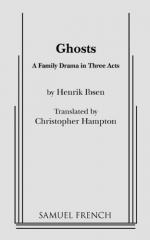|
This section contains 792 words (approx. 2 pages at 400 words per page) |

|
Realism
Realism, as a literary movement, flourished in the United States and Europe in the late 1800s, which is when Ghosts was written. In response to romanticism, which presented a version of reality that was twisted through human perception, realism marked an attempt to capture the truth about life, especially the ugly elements of truth that people would rather ignore. Realist literature is often associated with suffering, with disease and corruption, because these are the elements of life that romantic literature shied away from. Ghosts comes from a period in Ibsen's career that is considered his realist period, during which he wrote about social issues that disturbed him and his audience, with the hope that examining such unpleasant truths would lead to social change. In this play, he is unmasking the hypocrisy that is usually behind memorials to great civic leaders, looking at the damage that a man with...
|
This section contains 792 words (approx. 2 pages at 400 words per page) |

|




